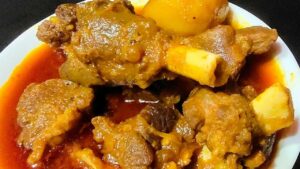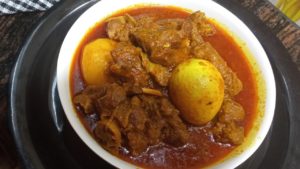Mutton Kosha is a delectable and aromatic Bengali dish that features tender pieces of mutton (goat meat) cooked in a rich and flavorful gravy.
It is a popular dish in Bengali cuisine and is often served during special occasions, celebrations, and festive gatherings.
The word “kosha” in Bengali refers to the process of slow-cooking or sautéing the meat in a thick, well-spiced gravy until it reaches a state of deep caramelization.
This slow-cooking technique helps to intensify the flavors and tenderize the meat, resulting in a dish that is succulent and packed with robust flavors.
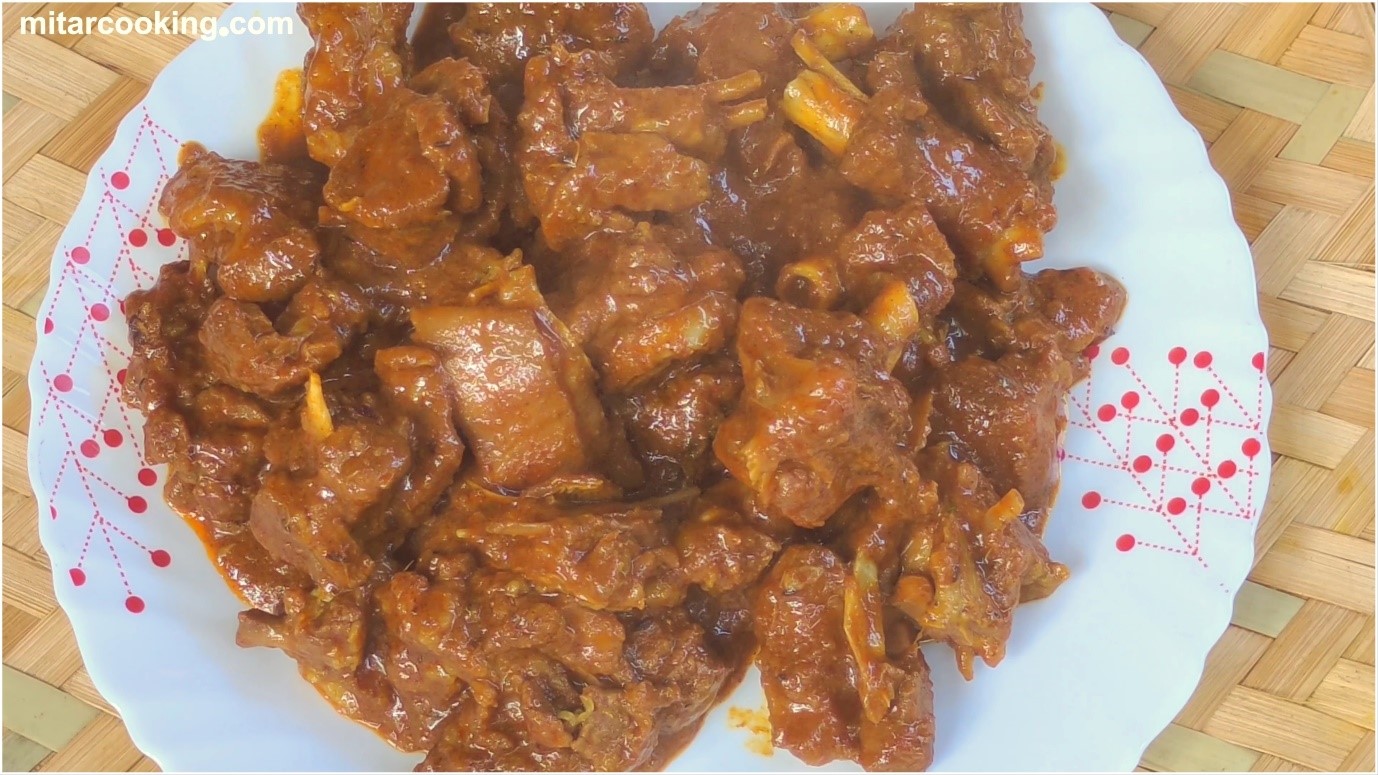
Key Takeaways:
- Mutton Kosha is a popular Bengali dish featuring tender mutton cooked in a rich and flavorful gravy.
- Mutton Kosha has a rich and robust taste with a moderate to high level of spiciness.
- It combines aromatic spices, caramelized onions, tangy yogurt, and tender meat to create a well-balanced and satisfying flavor profile.
- Mutton Kosha pairs well with steamed rice, pulao, roti, naan, luchi, or poori, allowing you to enjoy the flavorful gravy and meat with different accompaniments.
The Ingredients

- Mutton – 1 Kg (cut and cleaned)
- Onions – 2 Nos
- Ginger garlic paste – 2 Tablespoons
- Yoghurt – 100 gms
- Cinnamon Stick – 2 Nos
- Cardamom – 5 Nos
- Cumin seeds – Half Spoon
- Bay Leaf – 2 Nos
- Cloves – 2 Nos
- Black Pepper – 5 Nos
- Turmeric – 1 Tablespoon
- Kashmiri Red Chili Powder – 1 Tablespoon
- Red Chili Powder – 1.5 Tablespoon
- Sugar – Half Spoon
- Roasted Masala Powder (grinded roasted coriander, dry chili, cumin seeds)
- Coriander powder – Half Spoon
- Cumin powder – Half Spoon
- Javitri – ⅕ tablespoon
- Nutmeg – ⅕ tablespoon
- Salt – As required
How to Cook Mutton Kosha (Step by Step Images)?
1. Heat the fireplace or chulha or gas oven, heat a brass kadai or any wok you like to use for the cooking.
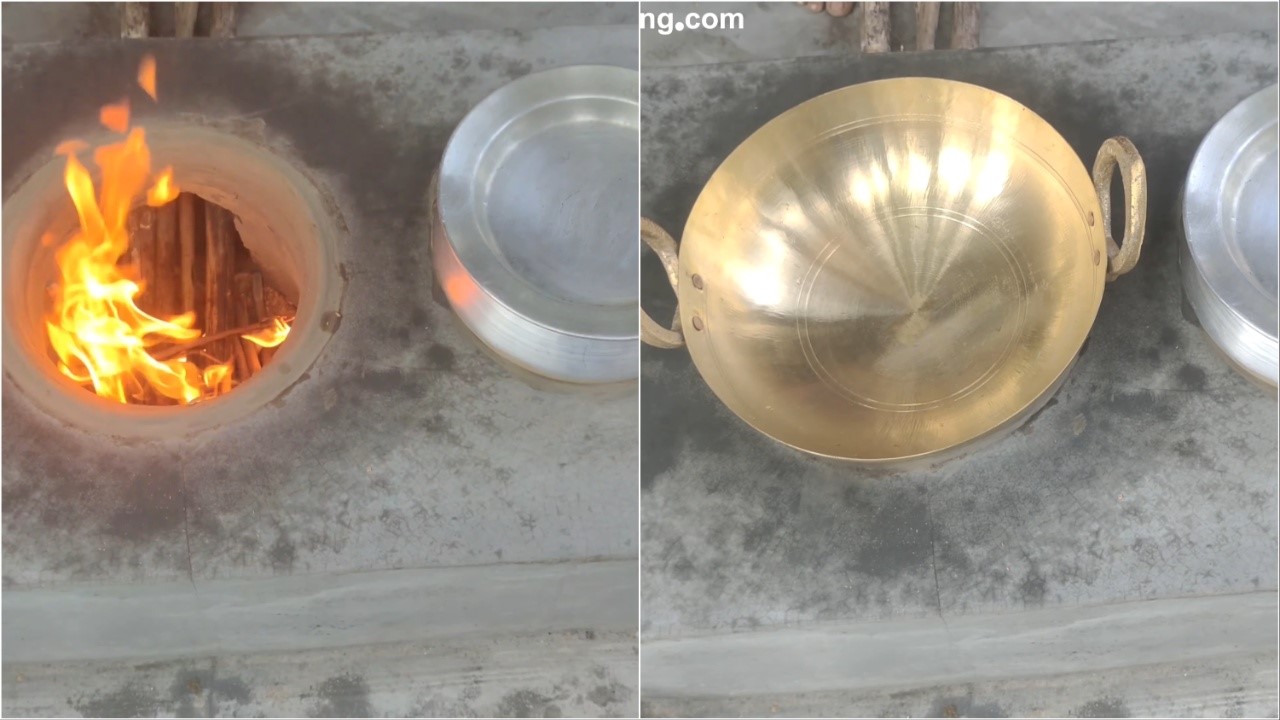
2. Add oil and heat the wok.

3. When the oil is hot, add all the whole spices like Cinnamon Stick, Cardamon, Cumin, Bay Leaf, Cloves, Black Pepper.

4. Add the chopped onions, fry it lightly and add the mutton pieces.

5. Stirring mutton nicely.

6. Add ginger garlic paste and stir fry it. When the raw aroma of the ginger & garlic paste goes out then add all the powder masalas like Turmeric, Kashmiri Red Chili Powder, Red Chili Powder, Sugar, Coriander, Dry Chili, Cumin, Coriander, Cumin and half spoon salt.

7. Sauté it for 10 mins. Cover it with a lid so that the water comes out from the mutton.

8. Add Nutmeg as required and the beaten yogurt, and mix it quickly so that the yogurt does not get bubbles in it.

9. Keep it for 5 mins and add lukewarm water (if you give normal water then it will slow the boiling process) as required to cook the mutton.

10. Cook it on low heat. After 25 mins add the garam masala and stir it well. By this time the mutton will get well cooked and your Mutton Kosha is ready.

Pro Tips for Cooking Mutton Kosha
Choose the right cut of meat: Opt for bone-in mutton pieces with some fat content. This will add richness and flavor to the dish. Shoulder or leg cuts are commonly used for Mutton Kosha.
Marination (OPTIONAL): Marinate the mutton pieces for at least 2-3 hours, or preferably overnight, to allow the flavors to penetrate the meat. Use a mixture of yogurt, ginger-garlic paste, and spices to marinate the meat. You can also add a little raw papaya paste to help tenderize the meat further.
Slow-cooking on low heat: Mutton Kosha is best cooked on low heat to allow the flavors to develop and the meat to become tender. Use a heavy-bottomed pan or a pressure cooker for slow-cooking. If using a pressure cooker, cook on low heat for about 45 minutes to an hour after the first whistle.
Caramelization is crucial: During the cooking process, ensure that the spices and onion paste are sautéed well until they turn dark brown and release their natural oils. This caramelization adds depth and richness to the gravy.
Don’t skimp on spices: Mutton Kosha is known for its rich and robust flavors. Don’t be shy when it comes to adding spices. Adjust the spice levels according to your preference, but be sure to include a good amount of aromatic spices like cinnamon, cardamom, and cloves.
Let it rest: Once the Mutton Kosha is cooked, allow it to rest for 10-15 minutes before serving. This helps the flavors to mingle and settle, resulting in a more cohesive and flavorful dish.
Garnish with fried onions (OPTIONAL): For an added touch of flavor and texture, garnish the Mutton Kosha with crispy fried onions before serving. This adds a delightful crunch and enhances the overall presentation of the dish.
Remember, cooking Mutton Kosha requires patience and attention to detail. It’s a dish that rewards those who take their time and allow the flavors to develop fully. Enjoy the process and savor the delicious results!
What to Serve with Mutton Kosha?
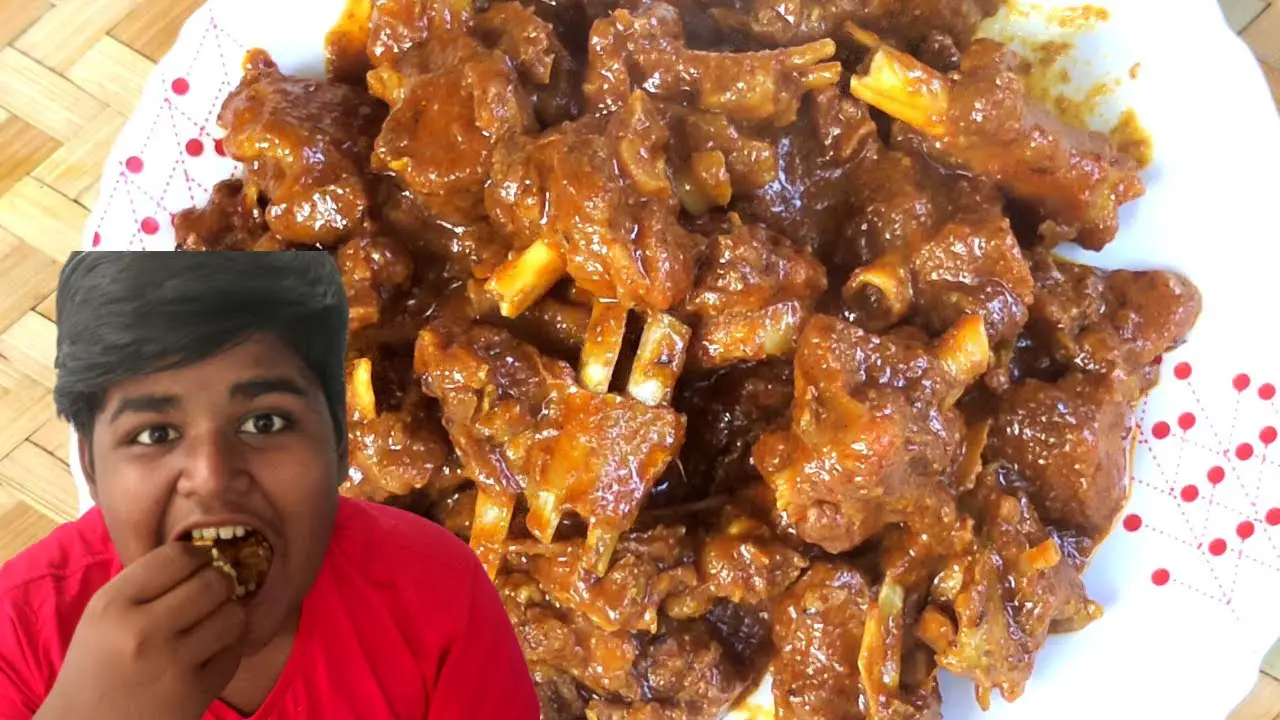
Here are some popular options to serve alongside Mutton Kosha:
Steamed Rice: Plain steamed basmati rice is a classic accompaniment to Mutton Kosha. The fragrant rice acts as a neutral base, allowing you to savor the flavors of the spicy meat gravy.
Pulao: A fragrant and lightly spiced rice dish like vegetable pulao or biryani can elevate your meal. The aromatic flavors of the pulao blend beautifully with the robustness of the Mutton Kosha.
Roti/Naan: Soft and fluffy Indian breads like roti, naan, or paratha are great options to scoop up the rich gravy of Mutton Kosha. They provide a nice contrast in texture and make the meal more filling.
Luchi/Poori: Luchi or poori, deep-fried puffed bread, is another popular choice to accompany Mutton Kosha. The combination of crispy bread and flavorful meat is indulgent and satisfying.
Remember to choose the side dishes based on your personal preferences and the preferences of your guests. The goal is to create a well-rounded and satisfying meal that complements the flavors of the Mutton Kosha. Enjoy your feast!
How Does Mutton Kosha Taste?
Mutton Kosha has a rich, robust, and complex flavor profile that is characteristic of Bengali cuisine. Here’s a breakdown of the taste elements you can expect when enjoying Mutton Kosha:
Richness: The dish is known for its deep, caramelized flavors that come from the slow-cooking process and the careful sautéing of the spices and onions. The gravy is thick and luscious, coating the mutton pieces with its richness.
Spiciness: Mutton Kosha typically has a moderate to high level of spiciness, depending on your personal preference and the amount of chili powder used. The combination of ground spices like cumin, coriander, and turmeric, along with red chili powder, creates a well-balanced heat that adds depth to the dish.
Aromatics: The dish is infused with the fragrant aromas of various spices such as cinnamon, cardamom, and cloves. These spices, along with ginger and garlic, provide a warm and enticing aroma that enhances the overall experience of the dish.
Meatiness: The mutton itself adds a distinct meaty flavor to the dish. When slow-cooked, the mutton becomes tender and succulent, absorbing the flavors of the spices and developing its own rich taste.
Balanced Flavors: Mutton Kosha is all about achieving a harmonious balance of flavors. The spiciness is balanced by the natural sweetness of caramelized onions and the tanginess of yogurt. The earthiness of the spices is complemented by the richness of the meat.
Overall, Mutton Kosha offers a delightful combination of intense flavors, making it a favorite among meat lovers. The interplay of spices, the richness of the gravy, and the tender mutton create a truly satisfying and memorable culinary experience.
Mutton Kosha Alternatives
If you’re looking for alternatives to Mutton Kosha, there are several dishes you can consider that offer similar rich and flavorful experiences. Here are a few options:
Chicken Kosha: This is a variation of Mutton Kosha where chicken is used instead of mutton. The cooking process and spices remain largely the same, resulting in a delicious and spicy chicken dish with a thick gravy.
Mutton Curry: If you enjoy the flavors of slow-cooked meat dishes, mutton curry is a fantastic alternative. Tender pieces of lamb are simmered in a fragrant and aromatic curry gravy, typically made with a blend of spices, onions, tomatoes, and yogurt.
Paneer Bhuna: For a vegetarian alternative, paneer bhuna is a great choice. Paneer, a type of Indian cottage cheese, is cooked in a similar manner to meat bhuna dishes. It is marinated, sautéed with spices, and simmered until it absorbs the flavors and develops a rich and spicy gravy.
Mushroom Bhuna: Another vegetarian option, mushroom bhuna, features mushrooms cooked in a thick and spiced gravy. The mushrooms soak up the flavors of the spices, creating a savory and satisfying dish that pairs well with rice or Indian breads.
These alternatives provide different options to explore the flavors and techniques of slow-cooked, spiced dishes, catering to a range of dietary preferences. Each dish offers its own unique taste and texture while capturing the essence of rich and flavorful Indian cuisine.
Recipe Card:

Mutton Kosha (Kosha Mangsho)
Ingredients
- 1 kg Mutton (cut and leaned)
- 2 pieces Onion (chopped)
- 2 tablespoons Ginger garlic paste
- 100 grams Yogurt
- 2 pieces Cinnamon Stick
- 5 pieces Cardamom
- ½ tablespoon Cumin seeds
- 2 pieces Bay Leaf
- 2 pieces Cloves
- 5 pieces Black Pepper
- ⅕ tablespoon Javitri
- ⅕ tablespoon Nutmeg
- 1 tablespoon Turmeric Powder
- 1 tablespoon Kashmiri Red Chili Powder
- 1½ tablespoon Red Chili Powder
- ½ tablespoon Sugar
- ½ tablespoon Coriander Powder
- ½ tablespoon Cumin Powder
- 1 tablespoon Roasted Garam Masala (grinded dry roasted coriander seeds, dry chili, and cumin seeds
- Salt to taste
Instructions
- Light the clay stove, or gas oven, and place a brass kadai or any preferred cooking vessel on it.
- Add oil to the kadai and heat it.
- Once the oil is hot, add the whole spices such as Javitri, Cinnamon Stick, Cardamom, Cumin, Bay Leaf, Cloves, and Black Pepper.
- Add the chopped onions and lightly fry them before adding the mutton pieces.
- Stir the mutton well to coat it with the spices and onions.
- Add ginger garlic paste and continue to stir-fry until the raw aroma dissipates.
- Now, add the powdered spices including Turmeric, Kashmiri Red Chili Powder, Red Chili Powder, Sugar, Coriander, Dry Chili, Cumin, Coriander, Cumin, and half a teaspoon of salt.
- Sauté the mixture for about 10 minutes, covering it with a lid to allow the moisture to release from the mutton.
- Add Nutmeg as required and beaten yogurt, and quickly mix it to avoid the yogurt from forming bubbles.
- Let it cook for an additional 5 minutes, and then add lukewarm water (using normal water may slow down the boiling process) as needed to cook the mutton.
- Cook the mutton on low heat. After 25 minutes, add the garam masala and stir it well. By this time, the mutton will be well cooked, and your Mutton Kosha will be ready to serve.
Video
Notes
Nutrition Info (Estimation Only)
Conclusion
If you follow the instructions of the entire preparation very well then you do not need to marinate or pressure cook the mutton. Just have a little patience and turn your mutton kosha into an excellent dish.
You need experience in making this into a perfect dish but if you are a first timer and you have an urge to make it perfect then do not worry, it will be perfect anyway.
In fact, if you check the taste the next day after preparation, it tastes much better than served instantly. All the spices penetrate it so well. Resulting in a much more perfect dish.

